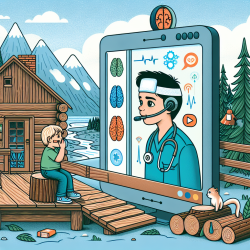Concussions are a significant public health concern among children and adolescents in Canada, particularly in rural and remote communities where access to specialized care is limited. Recent research, such as the study "The Potential of Telemedicine to Improve Pediatric Concussion Care in Rural and Remote Communities in Canada," highlights the promise of telemedicine to bridge these gaps in healthcare access. This blog will explore the key findings of this research and provide practical steps for practitioners to enhance their skills in pediatric concussion care through telemedicine.
Key Findings from the Research
The study underscores several critical points:
- Telemedicine can provide timely and effective concussion care to children in rural and remote areas, reducing the need for long-distance travel.
- Preliminary evidence suggests that telemedicine is both safe and cost-effective for managing acute concussions and persistent post-concussion symptoms.
- Telemedicine can facilitate access to multidisciplinary care teams, including neurologists, neuropsychologists, and physiotherapists, which is crucial for comprehensive concussion management.
Implementing Telemedicine in Concussion Care
Practitioners looking to improve their skills in pediatric concussion care can take the following steps:
- Leverage Existing Telemedicine Networks: Utilize provincial and territorial telehealth networks to connect with specialists and multidisciplinary teams.
- Adopt a "Hub-and-Spoke" Model: Establish comprehensive concussion centers as hubs that provide clinical coverage and consultative services to rural and remote spokes.
- Utilize Standardized Assessment Tools: Implement tools like the SCAT5 and Child SCAT5 for initial assessments and follow-up evaluations via telemedicine.
- Focus on Education and Training: Ensure that primary care providers in remote areas receive adequate training on concussion management and telemedicine technology.
- Engage in Continuous Research: Participate in collaborative studies to evaluate the effectiveness of telemedicine in concussion care and contribute to the development of best practices.
Encouraging Further Research
While the current research is promising, more studies are needed to address the limitations and barriers to telemedicine in concussion care. Practitioners are encouraged to:
- Conduct longitudinal studies to assess long-term outcomes of telemedicine-based concussion care.
- Investigate the patient and provider satisfaction with telemedicine services.
- Explore the use of advanced technologies, such as portable diagnostic tools, to enhance telemedicine assessments.
Conclusion
Telemedicine holds significant potential to improve pediatric concussion care in rural and remote communities in Canada. By implementing the research findings and engaging in continuous improvement and research, practitioners can enhance their skills and provide better outcomes for their patients.To read the original research paper, please follow this link:
The Potential of Telemedicine to Improve Pediatric Concussion Care in Rural and Remote Communities in Canada.










